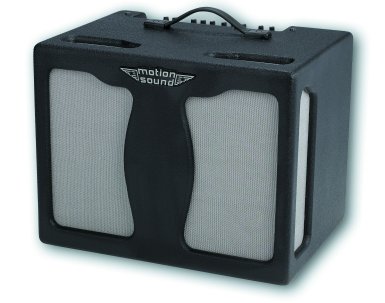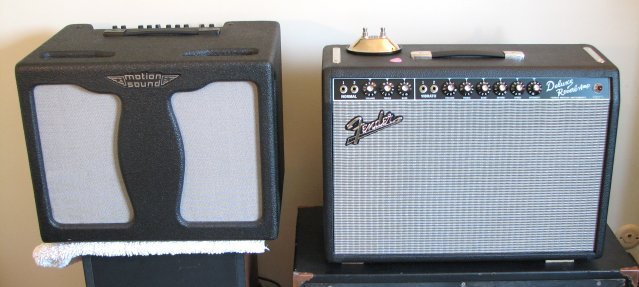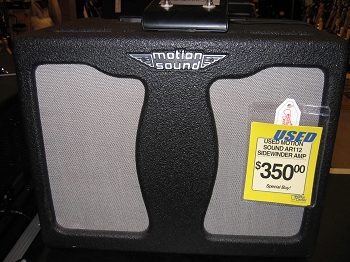Pawnshop Prize: The Motion Sound AR-112 Sidewinder

I LOVE swirly, three-D guitar sounds. I really do. I just love to hear the guitar swirl around a room. I originally fell in love with the swirly sound of the Leslie Rotating Speaker* in the late '60s and early '70s with Badfinger and George Harrison's early solo career. I then moved on into the lush Leslie sounds of Joe Walsh, first in the James Gang and then solo and with the Eagles. Somewhere along the line I discovered David Gilmour and was impressed with his lovely swirly sounds as well. Recently, after experiencing Pink Floyd s PULSE DVD, I became really absorbed in the complex rotating speaker sounds David was able to achieve seamlessly on stage with his custom "Doppola" rotating speaker units. I love the way he pipes echo through a Leslie for a REALLY spacey sound. Did I mention that I love swirly, three-D guitar sounds? Whatever. Through the years I could never afford a Leslie or the space to store it, so I bought the most popular simulator pedal around, the Hughs & Kettner Rotosphere. Perhaps the degree of my Leslie mania is best established by the fact that, despite owning the Rotosphere, when I discovered a Motion Sound Sidewinder rotating speaker guitar amplifier lying used in a local guitar store, I had to try it. I just had to. This interesting combo amplifier was produced between 2001 and 2005. The model is no longer produced, having been replaced by a similar but non-powered system designed to connect to your guitar amp. As a result, a pawn shop may just be the only place you can find one of these. I watched this one languish at the local guitar store for six months, during which I eventually fell in love with it. I suppose it was inevitable that it came home with me. In keeping with my policy of pursuing the trailing edge of the cutting edge of technology, I was able to procure it for a song and a dance.
PHYSICAL
The Sidewinder is a self-contained combo amplifier and rotating speaker system designed for direct interface with a guitar. Like that of the Leslies, the swirling effect of the unit is created by a spinning rotor which turns in front of a fixed speaker. Much like the Leslie models 16, 825, and 820, the AR-112 has one 12 wide-range speaker and no rotating tweeter horn. In a novel twist, the speaker faces towards the front of the enclosure and the rotor spins vertically in front of it. The smallish enclosure containing electronics, mechanics, and speaker, is finished in deep-textured black Polymaric and the sculpted speaker openings are lined in a contrasting dove gray speaker cloth. Reminiscent of an older Fender amp, the silver control panel is located at the back side of the top panel. The box, the jacks, and hardware feel solid and stout. The rotor mechanism is balanced and virtually silent and the whole mechanism is well thought-out and neatly executed. The handle is located so that the amp balances nicely when carried with the grille facing away from the body. Service access to all components is via removal of the bottom panel. Let s take a peek inside:

Inside looking towards the top. Back of unit is at bottom of picture.
Click for a larger pic and explanation.
Look HERE to compare to a Leslie 147A
ELECTRICAL
The Sidewinder's varispeed motor allows you to reproduce both the fast and slow Leslie sounds and move outside those bounds as well. A variable acceleration control also allows you to change the "ballistics" of the rotor speed change. It's not like the days of the old Leslie AC induction motors and relays: all changes are virtually silent. The preamp controls are pretty comprehensive: Once you adjust the unit to the output of your guitar or mic (via the rear-panel balanced XLR microphone input) with the panel-mounted "Pickup Gain" screwdriver trim, you can then use the "Gain" control knob to set the amount of distortion you want. The top-panel mounted 1/4" guitar jack and rear-mounted mic input share the same controls. To give the unit some musical growl, the preamp is built around a 12AX7EH tube. To allow control of the distortion created by the tube, the preamp offers pre- and post-gain EQ. A pre-gain "contour" control (an EQ centered around 800 Hz) is included to allow you to choose which frequencies will drive the tube. After the tube, standard, but very musical, Bass and Treble controls are included to allow you to shape the overtones put out by the tube. The Sidewinder sports a solid state, 100 watt RMS power amp that provides plenty of loud and smooth power to the Eminence Legend 12" Speaker. A popular observation is that 100 watts isn't as powerful in a rotating system as it would be in a direct-firing system. That's true, but this power amp is easily louder than that of a real Leslie and is plenty loud for club gigs. Any application beyond that can be handled by connecting the internal dynamic microphone to a PA system.

Sidewinder Control Panel viewed from Above
SOUND
Here we get to the bottom line of a rotating speaker system: The sound. The Sidewinder creates an extremely convincing and pretty rotational effect: neither too shallow nor too deep. The unit's preamp and controls allow you to reproduce all of the authentic Leslie sounds and some others as well. Specifically, the tweakable speed controls allow both authentic Leslie speeds and customization to optimize for a particular application. The owners manual, which can be downloaded from this site, HERE, suggests that you always tweak the slow speed control first because the value of the high speed control is simply an addition to the value selected by the low speed control. Rounding out its standard combo capabilities, the AR-112 offers an onboard, shock-mounted Accutronics spring reverb unit. Besides a send level control, an output tone control centered around 700 Hz is provided allowing you to shape the character of the reverb and remove "sproinginess." While its short tank doesn't submerge you as deeply as a Fender unit and probably can't do surf sounds, it is a very pretty sounding reverb and sounds great through the rotating speaker.
Being extremely picky here as a recording engineer with trained ears, I can make the following observations about the Sidewinder's rotary speaker sound: The sound is possibly not quite as amplitude modulated as that of the classic Leslie 147 due to its vertically-orientated rotor. I haven t tried this, but perhaps amplitude modulation could be increased by operating the unit lying down and blocked up to provide room for the back panel connections. It definitely is more emphasized when the internal mic is fed into a PA or recording system. The transitional complexity between speeds is also, perhaps, not as pronounced as that of a Leslie 147 due to the Sidewinder's single rotor, but that is true of any single-rotor system. However, the Sidewinder makes up for any shortfall in modulation with its absolute smoothness, "milkiness", and prettiness.

APPLICATIONS
The Sidewinder is very usable with a guitar plugged directly into it. The preamp EQs and tube preamp allow you to achieve a proper growl or a sparkly clean sound. Pink Floyd-esque cleans with a Strat are shimmery and clear. At slow speed, when some preamp growl is added, you get that classic, slow grind associated with the Leslie. Joe Walsh's "Meadows" sound and Badfinger"s "No Matter What" come easily with the right guitar and a few tweaks to the preamp. Now, the amplifier does have only one gain channel. Of course, in this modern day and age, we love to have multiple sounds available instantly, don't we? As a result, one of the ways you can make the Sidewinder really shine is by feeding it the output of your modeler or the preamp out of your amp. Just make sure to set the Sidewinder's preamp gain down to a clean sound and turn off the reverb so that you can control all that within the modeler or amp. With a modeler, you can serve it multiple sounds at will and the Sidewinder is easily powerful enough to serve as your main amp in small clubs. The unit can also be used in conjunction with another combo amp to spread your sound around the stage. When the volumes are matched and the Sidewinder is left to spin at a slow speed, your guitar sound gently undulates from side to side between the amps. David Gilmour uses this effect extensively.
A COMPARISON WITH THE ROTOSPHERE
Sidewinder:
In person, a real rotating system provides a much more lush experience than a simulator. Variable speed allows a bit more flexibility than the Rotosphere, which strictly models the Leslie's two speeds. Since this is a self-contained amp, there won t be any signal loss, extra cables, power supplies, or patching complexity added to your rig. If used with a modeler, you need only haul this single unit as your amp for a gig.
Rotosphere:
In a recording situation, the Roto may more realistically simulate the complex sound of a Leslie 147's dual rotors during speed transitions than the Sidewinder. You can set the rotor on slow, momentarily tap the brake switch, and hear the rotors loose synchronization. You can also hear that same complexity of lost synchronization as the unit changes speed. By the way, when the two channels are recorded directly and panned outboard in a stereo field, it is best to pull the two channels inwards a little to get a more cohesive image. Live, you'll need to transport two pretty well matched amps to get a realistic spacial effect from the unit.
OVERALL IMPRESSION
So what is the final verdict? This unit is MUCH easier to transport, store, and interface with than a full-sized Leslie. While taking up little more footprint than a small combo, it provides much of the sound quality of a Leslie 147 without its attendant hassles of size, bulk, and interface complexity. The built-in mic makes the unit easy to connect to a PA, much like a customized Leslie cabinet. It also makes a great start for a recorded sound. The internal mic's position guarantees plenty of amplitude modulation. And the sound? The sound is simply gorgeous! Liquid, shimmery, and swirly. When I connected up my modeler with some echo and got it tweaked, I was immediately inspired to figure out the intro from the Floyd's "Shine On You Crazy Diamond"... on the spot. Brilliant!
Motion Sound maintains an active website HERE and provides product support via email and telephone. Parts and a road spares kit are also available. My call for information was answered courteously and a parts order (new logo) was handled expeditiously.

Ins and Outs: The Back Panel
CONNECTIONS
Mains power equipment end connector with integrated fuse box
Unbalanced 1/4" guitar in
Balanced XLR Mic In
Balanced XLR Dynamic Mic Out (marked "Line Out")
TRS 1/4" Footswitch jack
CONTROLS AND INDICATORS
Preamp:
Pickup gain, Gain, Contour (800 hz, pre-gain stage)
Volume, Bass, Treble (all post gain stage)
Preamp:
Rotor Slow, Rotor Fast Speed, Rotor Acceleration
Reverb:
Volume, Tone (return)
Power On/Off (on back)
LED power indicator
Two-button, LED-equipped proprietary footswitch:
Stop (brake) latching footswitch (LED lights when stop is selected)
Speed selector (LED lights when high speed is selected)
DIMENSIONS
Size 15.5"H x 20"W x 14.5"D
Weight: 40 lbs

Alongside a friendly Deluxe Reverb to show scale
TECHNICAL NOTES
1. Unit is designed so that the rotor comes to a full stop when the stop footswitch is engaged. Over time however, electrical alignment may drift causing the rotor to wander slightly when stopped. Motion Sound has provided an internal trim pot to restore the stop function. Go HERE for more. With that said, if the Sidewinder is used in a tandem configuration with another amp, just a little bit of rotor wander can be really cool to keep the sound spread across the stage. But if it is used by itself, you may want to go ahead and balance the rotor at a stop.
2. Early models had lower gain than the later ones. The Motion Sound site offers a two-resistor substitution to increase the gain and sustain, HERE, and gives you the serial numbers affected by each substitution.
3. Another mod is available on the website to allow greater volume and treble by trimming the edge of the rotor. Of course, this mod would be irreversible. Look HERE for more.
4. It appears that the above mentioned mods (2 & 3) were developments that occurred during the production cycle of the amplifier. As a result, an individual amp may already contain them.
5. Early versions of the Sidewinder were covered in Tolex and had chrome corners and hardware and rectangular speaker openings.
*Note: If you need an explanation of the original Leslie rotating speaker system and the physics of its sound, motor on over HERE.

In the store, before a little price negotiation
July 24, 2007
= =
=







